- how many audience or group members require language support?
This will determine the number of primary and backup receivers to rent.
this guide helps you evaluate if a simple-to-operate, tour guide style, wireless portable RF system is the right solution for the type of event you are planning. The alternative is a conference interpretation system with a more powerful stationary transmitter.
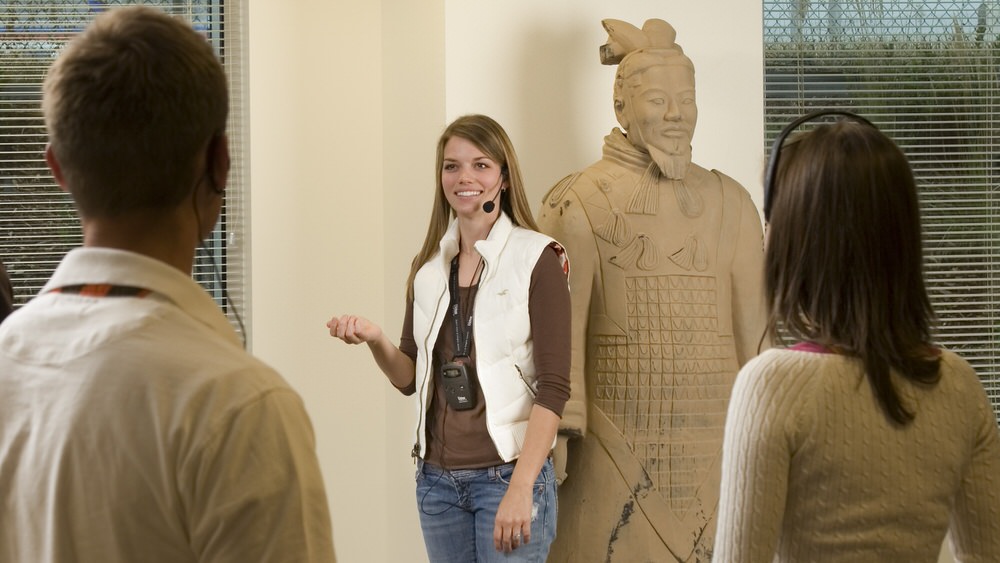
Portable FM system in tour group setting.
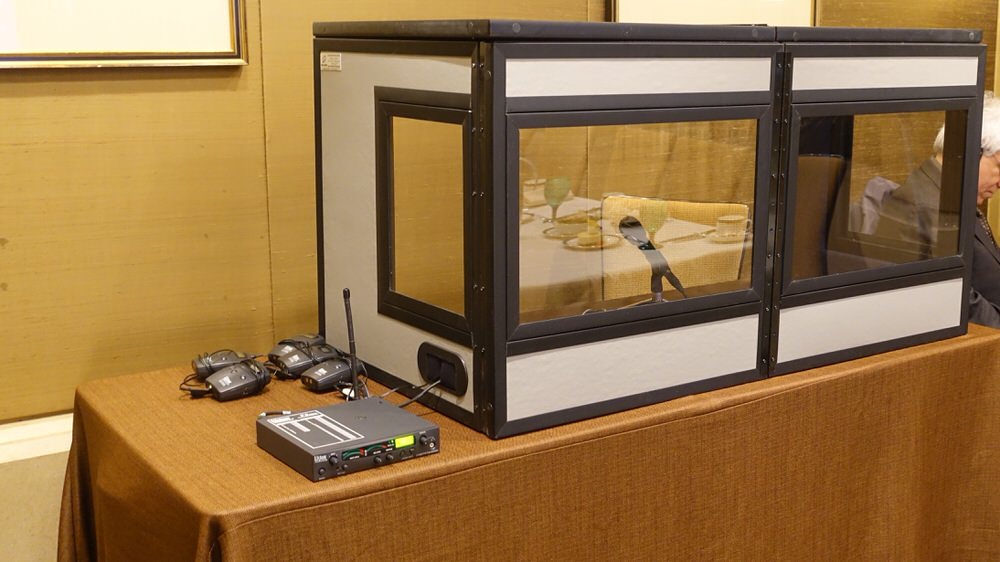
Conference FM system next to tabletop interpreter booth.
RF is the acronym for Radio Frequency and FM stands for Frequency Modulated. While the terms RF system and FM system are frequently used interchangebly, and all FM systems are RF systems, an RF system is not always FM. It can for example be AM or FSK modulated. For the purposes of this guide we focus on RF devices which operate as analog systems in the FM band.
dissemination of language interpretation via wireless FM radio transmission is a commonly used technology for the one-to-many meeting model, such as a presentation or lecture, where one person speaks and the audience listens. A variation of this would be a panel discussion with panelists and a moderator. Visiting delegations use tour guide style portable FM systems when they need language interpretation during their trip. These portable FM systems can also be used for meetings taking place in a fixed location.
this guide assumes a basic understanding of meeting planning, conference and simultaneous interpretation setups. If you are new to organizing meetings with simultaneous interpretation, get up to speed with our Beginner's guide to Wireless Simultaneous Interpretation Equipment Rental with a focus on one-to-many meetings.
professional transmitters – both portable and stationary models - operate much like an FM radio station and are a fast and frequently used solution to broadcast simultaneous interpretation via radio waves.
the FM transmitter is connected to the audio source you want to broadcast and an available FM frequency is selected to broadcast the interpretation. The transmitter picks up the live audio directly from the interpreter console or a microphone. Those sounds are then broadcast over an FM radio signal. The audience members in need of language support wear FM receivers, which are tuned to the same frequency as the transmitter to receive a reliable, clear sound signal from the audio source.
in an optimal RF environment, the broadcast can be picked up from a distance of up to 150 ft using a portable FM transmitter and up to 1500 ft using a stationary FM transmitter). An RF environment is considered optimal when:
a stationary FM wireless conference interpretation system is configured with:
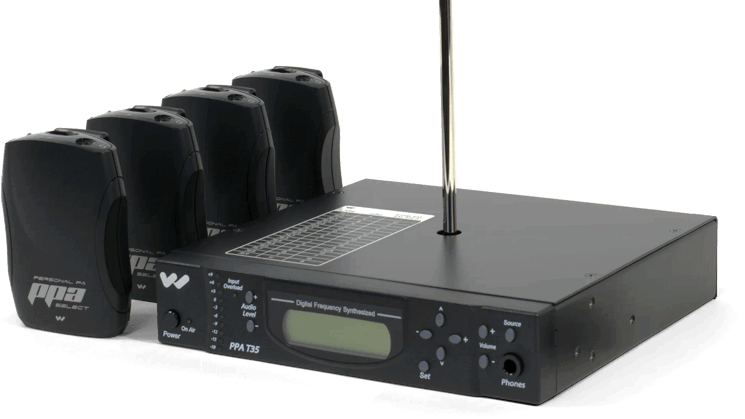
Stationary FM transmitter and receivers.
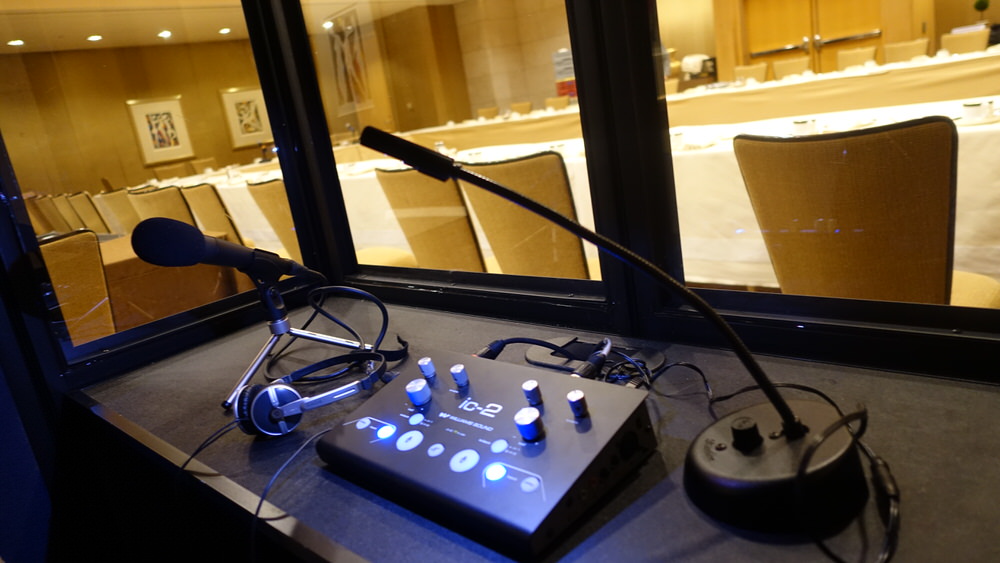
Analog interpreter console with headphones and mic.
a stationary FM system is often complemented with one interpreter isolation booth per team of two interpreters assigned to a language direction. In some situations, two interpreters able to interpreter into two-language directions, such as for example English into Spanish and Spanish back into English, share the same booth.
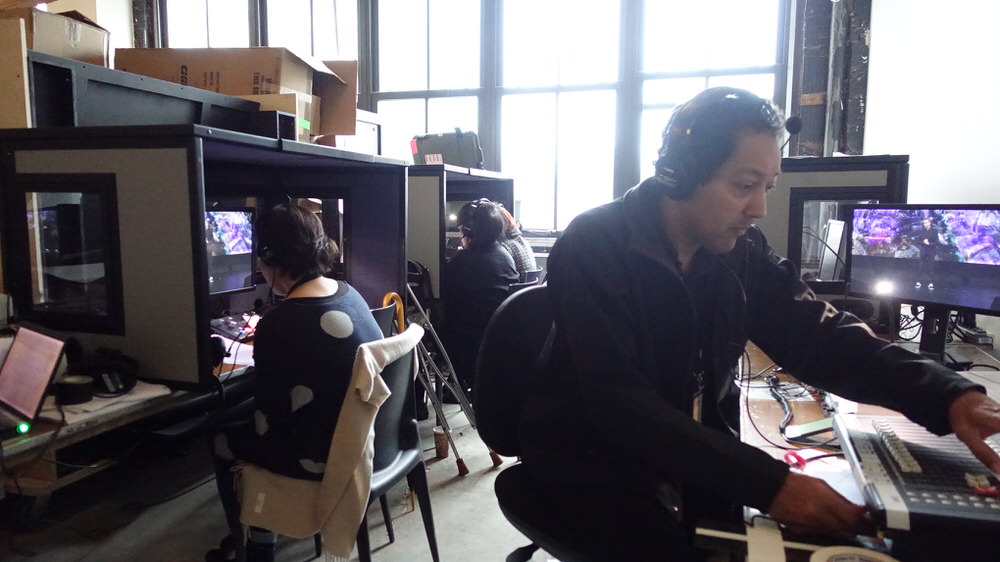
Interpreters stationed at tabletop interpreter booths next to our iProbe SI tech.
the stationary transmitter has a working range of 750-1500 feet and has the advantage of a flexible configuration for a multitude of audio sources. The transmitter is AC powered and the receivers are battery powered.
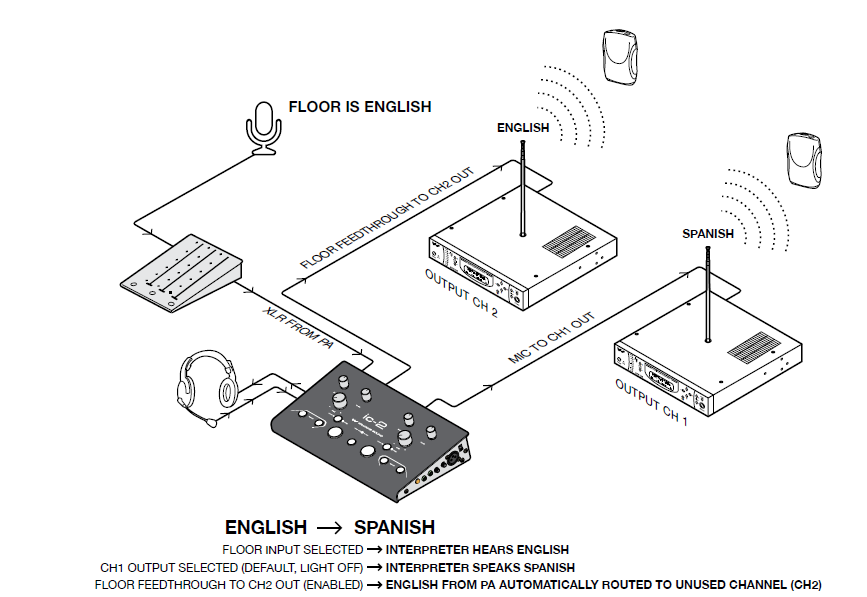
One way RF system with a stationary (desktop) FM transmitter, an analog interpreter console and two FM receivers configured for 2 languages. Additional FM receivers can be added at will.
the setup, operation and dismantling of a stationary FM system is typically done by audio visual technicians trained to operate wireless interpretation equipment and referred to as simultaneous interpretation technicians, or SI technicians.
this type of full-service rental is a good solution for events where the meeting organizers prefer to rely on a professional service provider to facilitate a smooth simultaneous interpretation experience.
The FM system setup can be simplified by eliminating the interpreter console and replacing the stationary FM transmitter with a light-weight, battery-powered, portable FM transmitter, which has a range of up to 150 ft.
the portable transmitter is very similar in shape to the receivers and, just like the receivers, it can be hand held, placed on a hard surface like a table, clipped on the belt, placed in a pocket or carried around the neck using a lanyard.
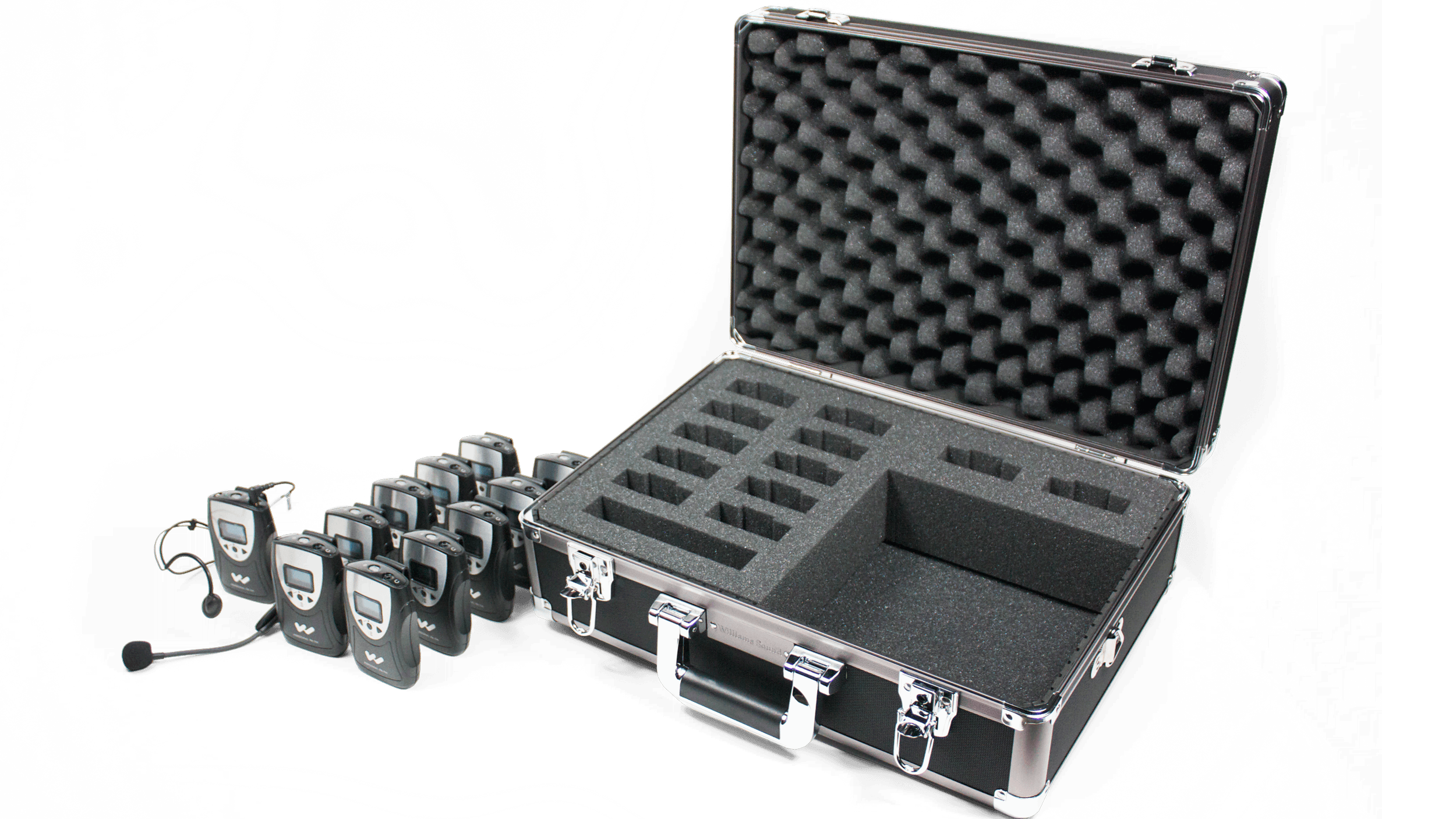
Portable FM transmitter and receivers.

Portable FM transmitter and receivers in use during tour.
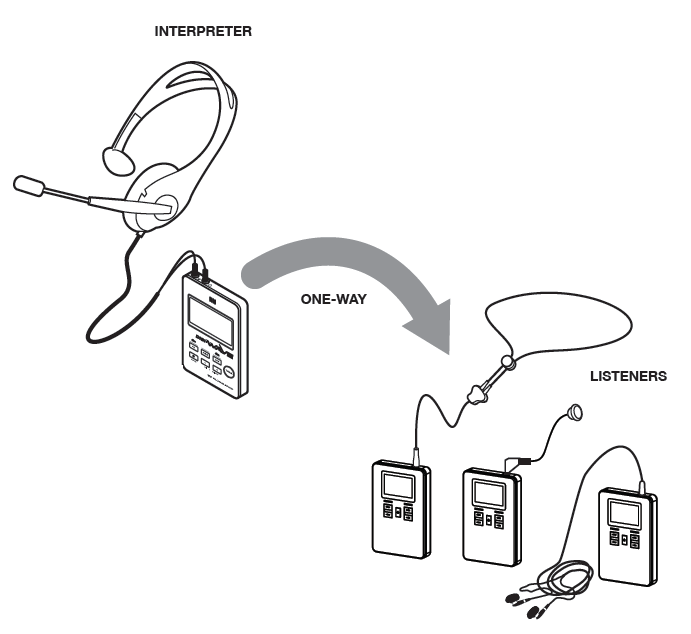
One way system with a portable (bodypack) FM transmitter and three FM receivers. Additional receivers can be added at will.
this type of setup, frequently referred to as a bodypack FM system, is an economic interpretation equipment rental solution simple enough for someone with limited tech knowledge to operate, without the need for an SI technician.
the ease of use of the portable FM transmitter and the absence of the interpreter console make the beltpack system ideal for interpreters working with a small group, for walking tours and for business groups who travel to different locations with their own interpreter. It can also be a good solution for meetings taking place in a small room. However, the bodypack system has limitations compared to the more powerful and versatile stationary FM interpretation systems and thus is not suitable for all environments and events.
The following considerations are a good starting point to determine if a portable RF system could be a good fit for your event and what system configuration you will need for the simultaneous interpretation.
a bodypack RF system is a cost effective solution to transmit simultaneous interpretation provided certain conditions are met. Some of the discussed variables that can reduce the range or weaken the transmission signal are hard to predict without onsite testing. To warrant a seamless interpretation experience, try to test the bodypack RF interpretation system onsite ahead of time to figure out the actual transmission range you have available.
if you experience dropouts in some areas or on some channels and changing the room layout or the channel doesn't solve the problem, you can contemplate upgrading to a more powerful system and have the technical aspects handled by a professional service provider. Testing in advance will give you enough time to do this.
there is technically no limit to the number of RF receivers that can be used in conjunction with the bodypack RF system, although best results may be achieved in smaller settings with 20-30 attendees in need of interpretation. You can try using the system with more attendees as long as everyone is within the working range of the portable FM transmitter. As you plan the layout of the room try to keep everyone needing language support close to the interpreter and try to test beforehand.
call us at 212-489-6035 to speak with a interpretation equipment specialist.
learn more about our interpretation equipment rentals.
*NOTICE: This guide is provided to iProbe customers to help prepare for use of interpretation services and interpretation equipment rental and reduce the possibility of issues occurring at time of event due to improper operation of interpretation equipment by customer or insufficient planning during the event preparation phase. It is NOT intended to be a comprehensive guide for renting interpretation equipment or contracting interpretation or related services. We make no warranties, express or implied, regarding this information. Proper event planning is the sole responsibility of the organizer. For more information and additional guidelines, refer to your contract, or contact iProbe. Refer to the current iProbe Service Guide for terms, conditions, and limitations applicable to iProbe services.